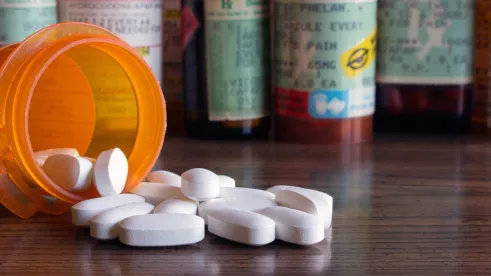In a rare act of bipartisanship, Senate Finance Committee Chairman Chuck Grassley, R-Iowa, and Ranking Member Ron Wyden, D-Ore., introduced on July 23rd a chairman’s mark, the Prescription Drug Pricing Reduction Act (PDPRA) of 2019 (the “PDPRA” or “Mark”), to lower the price of prescription drugs for Americans. According to the Committee, the Congressional Budget Office (“CBO”) projects that the PDPRA would save taxpayers more than $100 billion in Medicare and Medicaid spending over 10 years, lower Medicare beneficiaries’ out-of-pocket costs by $27 billion and lower beneficiaries’ premiums by $5 billion. The bill passed out of committee by a 19-9 vote on July 25th.
Reaction to the Mark has been mixed. For example, the Pharmaceutical Research and Manufacturers of America criticized the PDPRA as the “wrong approach to lowering drug prices” and predicts it will “siphon” billions of dollars away from research and development without benefitting seniors at the pharmacy counter. America’s Health Insurance Plans was “encouraged” by the Committee’s work and expressed its readiness to work with Congress and the Administration.
Medicare Part B Provisions
The proposed changes to Medicare Part B are aimed mainly at closing avenues by which manufacturers and providers might increase the reimbursement they receive, as well as at requiring certain rebates to the Medicare program. By limiting reimbursement and pulling back money as rebates, the Medicare provisions could result in substantial savings to the program. In addition, the Mark contains provisions addressing site-of-service reporting and impact on reimbursement.
Direct Impacts on Drug Reimbursement Amounts
Impact on ASP Reporting and Calculation
Medicare drug pricing depends in part on the Average Sales Price (“ASP”) of a drug, as reported by its manufacturer. The Mark would expand ASP reporting requirements, as well as require the exclusion of the value of manufacturer coupons from the calculation of ASP. These measures would tend to, respectively, improve the accuracy of and lower reported ASPs, potentially lowering the prices that Medicare pays for drugs.
The Mark would also change the way that service fees paid in drug transactions are treated in the calculation of ASP. When such fees are not deducted from ASP, ASP tends to be higher. In particular, the Mark would establish a narrower statutory definition of the “bona fide service fees” that manufacturers would be allowed to exclude from the calculation of ASP. Any fee based on the percentage of sales or determined in a manner that takes into account volume or value of referrals or business generated between the parties could not be deducted.
Impact on Add-On Amounts to ASP and WAC
In some cases, Medicare drug pricing depends on the Wholesale Acquisition Cost (“WAC”), a published price not adjusted for discounts and generally higher than ASP. In the past, Medicare reimbursement has included a six percent add-on, regardless of whether pricing is based on ASP or WAC. Beginning January 1, 2019, the Centers for Medicare and Medicaid Services (“CMS”) has shifted to a three percent add-on in circumstances wherein reimbursement is based on WAC instead of ASP. The Mark would also adopt a similar CMS rule for biosimilar reimbursement that is based on WAC. However, to encourage the development of lower priced biosimilar products, the Mark would also provide for a temporary eight percent add-on to ASP for a five year period beginning January 1, 2020.
The Mark would also establish a $1,000 cap on the add-on amount that a provider could be paid for a separately payable drug, biological, or biosimilar beginning January 1, 2021. This cap would apply through December 31, 2028, after which time it could be adjusted for inflation.
Rebates
The Mark provides for two new rebate requirements for manufacturers. The first would apply to manufacturers that increase drug or biological costs beyond inflation for amounts by which the price of a product increased above the inflation rate. The other relies on provider-reported data about unused units of a drug or biological contained in a single use vial, and would require manufacturers to rebate the amount by which Medicare payment made for unused portions of certain single-dose vials exceeds ten percent of the amount Medicare paid for the total units. The Mark also provides for a new civil monetary penalty for manufacturers that fail to pay required rebates equal to 125% of the required refund amount.
Site-of-Service Provisions
Currently, the Department of Health and Human Services (“HHS”) is required to publish Medicare estimated payments to hospital outpatient departments and ambulatory surgery centers, along with the estimated beneficiary cost-sharing liability in each setting, allowing beneficiaries to compare their potential costs of receiving care in different settings. The Mark would expand this transparency tool to require publication of the estimated payment to a physician under the Medicare physician fee schedule, with associated beneficiary cost-sharing liability.
The Mark would also change the way in which the professional service of administering a Medicare Part B drug is paid when the administration occurs in a “grandfathered” off-campus hospital outpatient department. Specifically, such services would be paid at the physician fee schedule rate instead of the outpatient prospective payment schedule rate beginning January 1, 2021.
Medicare Part D Provisions
The Mark would “modernize and improve” Part D by, among other changes, simplifying the Part D’s standard benefit; implementing an out-of-pocket spending cap; increasing transparency into pharmacy benefit manager (“PBM”) practices and drug manufacturer pricing decisions; and protecting the Part D program from manufacturer drug price increases.
Provisions Addressing Part D’s Benefit Design and Beneficiary Eligibility
Part D Benefit Redesign
Part D sponsors must offer standard coverage that consists of:
-
A deductible ($415 in 2019);
-
Initial coverage in which the enrollee is responsible for 25 percent of the cost of drugs (with the Part D plan covering the remaining 75 percent);
-
A coverage gap in which the enrollee is responsible for coinsurance of 25 percent of the cost of brand-name drugs and 37 percent of the cost of generic drugs, Part D plans covering the remaining 63 percent of generic drug costs and 5 percent of brand-name drug costs, and manufacturers providing discounts for the remaining 70 percent of brand-name drugs; and
-
Catastrophic coverage in which the enrollee is responsible for 5 percent of drug costs, their plans are responsible for 15 percent of costs, and Medicare subsidizes 80 percent of costs (the reinsurance subsidy).
The Mark would simplify the standard benefit starting January 1, 2022 by:
-
Eliminating the coverage gap and establishing a 25 percent cost-sharing requirement between the annual deductible and the catastrophic threshold;
-
Setting the catastrophic out-of-pocket threshold at $3,100 in 2022 and indexing it to Part D spending growth;
-
Reducing federal reinsurance payments from 80 percent to 20 percent and increasing sponsors’ responsibility to 60 percentage of drug costs during catastrophic coverage; and
-
Sunsetting the current manufacturer coverage gap discount program and replacing it with a new manufacturer discount program in which participating manufacturers provide discounts for drugs and biologics utilized during catastrophic coverage. Participating drug manufacturers would provide 20 percent discounts off negotiated prices during catastrophic coverage, including for low income subsidy (“LIS”) beneficiaries.
Make the Limited Income Newly Eligible Transition Pilot Permanent
To address potential gaps in coverage for low income beneficiaries who qualify for the Part D LIS but are not yet covered by a Part D plan, the Limited Income Newly Eligible Transition (“LI NET”) pilot program was authorized in 2010 to provide immediate temporary Part D coverage for certain LIS individuals. The Mark would permanently authorize the LI NET program, beginning no later than 2022. Individuals would qualify for LI NET if they were either full or partial LIS-eligible and either (i) had not yet enrolled in a Part D plan or (ii) had enrolled, but coverage under the plan had not yet taken effect.
Provisions Addressing Data Access and Transparency
Access to Drug Price and Rebate Data
Currently, health insurers and drug pharmaceutical manufacturers that participate in Medicare Part D or Medicaid must provide drug price information to HHS for use in program payment and administration. Federal law protects the confidentiality of that data.
The Mark would, effective immediately, allow HHS to share Medicare Part D and Medicaid drug price and rebate data with the executive directors of MedPAC and the Medicaid and CHIP Payment and Access Commission (MACPAC) for purposes of monitoring, program recommendations, and analysis of the Medicare Part D and Medicaid programs and the State Children’s Health Insurance Program. MedPAC and MACPAC would be prohibited from publicly disclosing the reported data.
Public Disclosure of Drug Discounts and Other PBM Provisions
PBMs currently report limited information to their health insurers customers and the government. The reported data is confidential. The Mark would make certain PBM data publicly available as well as require Part D sponsors to conduct financial audits of their PBMs. Additional reporting obligations would be imposed on sponsors.
-
HHS would post the following PBM information on its website beginning on July 1, 2022: information on aggregate price concessions (including rebates and discounts) as well as the aggregate amount of the difference between what an insurer pays a PBM, and what a PBM pays retail pharmacies and mail order pharmacies, and the number of prescriptions dispensed.
-
Part D sponsor audits would beconducted at least every two years by an independent third party for the purpose of monitoring the PBM’s contractual compliance. PBM’s would have to disclose their drug rebate agreements for audit.
-
Part D sponsors would also have to report to pharmacies claim level (if available) point of sale adjustments for price concessions or incentives.
Reporting Part D Direct and Indirect Remuneration
Under Part D, sponsors may pass on to enrollees the full value of any rebates and discounts negotiated with manufacturers and pharmacies in the price enrollees pay at the pharmacy counter. Drug price concessions that are not passed on to enrollees at the point of sale are reported to CMS as direct and indirect remuneration (“DIR”) and used to reduce the sponsor’s drugs costs that are subject to the Part D risk corridors provisions that limit sponsors’ overall profits and losses under Part D.
The Mark would require Part D sponsors to report, beginning in plan year 2022, actual and projected DIR amounts in their Part D bids to ensure that projected DIR related to pharmacies and manufacturers is based on actual remuneration in a prior year. A separate provision would require the Secretary to publicly report on discrepancies in sponsors’ DIR submissions.
Provision of Parts A and B Claims Data to Drug Plans
The Bipartisan Budget Act of 2018 requires HHS to establish a process, by 2020, under which a Part D sponsor could request Medicare Parts A and B medical claims data for their drug plan enrollees. The data could be used for such purposes as improving therapeutic outcomes by improving medication use and improving care coordination to prevent adverse outcomes such as emergency room visits. The data could not be used to inform Part D coverage determinations. The Mark would allow sponsors to use the data for Part D coverage determinations related to approved purposes.
Medicare Part D Rebate by Manufacturers for Certain Drugs
In contrast to the best price requirements for manufacturers under Medicaid, drug manufacturers are not required to participate in Part D and are not required to provide price concessions from their list prices. As mentioned above, the Mark would establish a mandatory rebate if a drug manufacturer increases their list price for brand drugs or biologics above inflation. Manufacturers would enter into rebate agreements with the Secretary for their drugs to be covered under Part D, and would be required to provide specific information to HHS to implement the rebate. Manufacturers would be subject to HHS audits to ensure reporting compliance and civil monetary penalties for noncompliance. Rebates paid to Medicare would be deposited into the Medicare Supplementary Medical Insurance Trust Fund.
Increasing Use of Real-Time Benefit Tools to Lower Beneficiary Costs
Part D sponsors are required to support an electronic prescription (e-prescribing) program, which enables transmission of prescription information between a clinician, pharmacy, PBM, and/or the sponsor. This provision would require Part D sponsorsto provide for a real-time benefit tool (“RTBT”) that enables electronic transmission of formulary and benefit information to each enrollee’s prescribing clinician, using technology that integrates with clinicians’ electronic prescribing and EHR systems. Information transmitted would include, among other information, a list of any clinically-appropriate alternatives to a drug included on the formulary of such plan and pharmacy options. Tools used by clinicians would also be added and would enable physicians to get credit for using a RTBT in the Medicare physician fee schedule Merit-based Incentive Payment System (“MIPS”) by adding it to a menu of practice improvement activity options.
Drug List Price (WAC) Transparency
Starting in July 2022, the Mark would require drug manufacturers to provide and HHS to publish detailed information supporting list prices for certain costly new drugs and biologics, as well as price increases exceeding specified thresholds for certain established drugs and biologics. The price transparency requirement would apply to new drugs and biologics if the cost of a year’s supply or course of treatment exceeds the gross spending for covered Part D drugs necessary to meet the annual out-of-pocket threshold, which is projected to be approximately $10,000. The reporting requirements also would apply to certain price increases affecting two categories of established drugs or biologics: those with a list price of at least $10 per dose, and those in the top 50% of Medicare or Medicaid net spending per dose in any of the five years preceding the increase. Failure to timely submit a required justification would carry a civil penalty of up to $10,000 per day.
Prescription drug price increases are the subject of a lawsuit filed on May 10, 2019 by a coalition of 44 states against 20 generic drug manufacturers alleging antitrust law violations resulting in significant price increases affecting dozens of generic drugs. The drugs named in the lawsuit generate billions of dollars of sales in the United States, a substantial portion of which represents Medicare and Medicaid spending.
The Mark seeks a wide range of information under the price transparency provision, but in a nod to federal antitrust enforcers’ repeated admonitions against the potential for price transparency to harm competition, the Mark would enable HHS to withhold proprietary information at the manufacturer’s request if HHS determines that disclosure would lead directly to increased drug prices. Factors HHS could require or encourage manufacturers to disclose include the costs of patents and licenses, the manufacturer’s metrics for setting executive compensation, research and development spending for drugs failing to attain FDA approval, marketing and advertising costs, and total revenue and net profit.
Permissive Exclusion
Currently, the HHS OIG can exclude health care providers from federal health care program participation. The Mark would expand this authority by also allowing exclusion of individuals and entities affiliated with sanctioned entities. In particular, HHS would be permitted to exclude individuals with an ownership or control interest in a sanctioned entity or its affiliate, or who had such an interest at the time the misconduct occurred.
Medicaid Provisions
According to the CBO, the Medicaid-related provisions of the Mark could save the federal government approximately $15 billion. The Mark’s Medicaid provisions can be categorized into two broad categories: (i) provisions addressing potential conflicts of interest in formulary development and drug utilization review and increasing transparency into prescribing patterns; and (ii) provisions that reduce the prices Medicaid pays for covered outpatient drugs.
Provisions Addressing Conflicts of Interest and Increasing Transparency
Medicaid drug pricing often turns heavily on decisions made by the state committees that develop formularies and review drug utilization. Because of the key role these committees play, the Mark proposes measures to better insulate these committees from potential conflicts of interest. In particular, the Mark would require each state to implement a pharmacy and therapeutics (“P&T”) committee conflict of interest policy that would be publicly accessible, require all committee members to disclose annually any relationships that might affect their independent judgment on committee matters, and identify processes, such as recusal from voting or discussion, for those members who report a conflict of interest. Each state would be required to include at least one practicing physician and one practicing pharmacist who have no manufacturer, Medicaid managed care plan, or PBM conflicts of interest. The Mark would also require each state to apply these P&T committee requirements to formularies used by managed care organizations.
The Mark would also require each state to establish and implement a similar drug utilization (“DUR”) board conflict of interest policy and would require that Medicaid managed care plans comply with conflict of interest reporting requirements for their DUR boards. In addition, the Government Accountability Office would be obligated to investigate potential and existing state Medicaid program DUR board and P&T committee conflicts of interest and to submit a report to Congress summarizing its findings.
The Mark also proposes to improve transparency into Medicaid provider prescribing patterns by requiring HHS to annually publish a report that features a comparison of drug prescribing patterns across several dimensions, including but not limited to (i) patient demographic characteristics such as race, gender and age, and (ii) high-utilizer or high-risk patient status. The report would be required to include an analysis of the differences in prescribing patterns for patients in managed care plans as compared to patients participating in fee-for-service.
Provisions to Reduce the Prices Medicaid Pays for Covered Outpatient Drugs
The Mark would address Medicaid drug pricing through a variety of measures targeted at manufacturer rebates, calculation and reporting of Average Manufacturer Price (“AMP”), and PBM practices. This multi-faceted approach touches on some of the core drivers of drug pricing under Medicaid by creating a new category of potential state arrangements with manufacturers, expanding the amount and scope of manufacturer rebates, improving AMP calculation accuracy, and reining in PBM profits on pricing “spreads.”
Flexibility for and Expansion of Manufacturer Rebates
Many pharmaceutical manufacturers currently enter into rebate agreements with HHS to return a per-unit amount of money to the Medicaid program, calculated based on a statutory formula. The Mark would expand the rebates the Medicaid program could receive, both by creating a new class of risk-sharing rebate agreement for certain gene therapies, and by increasing both the current maximum rebate amount and the scope of drugs on which rebates must be paid.
Risk-Sharing Arrangements for Gene Therapies
The Mark would enable states to pay for certain gene therapies for rare diseases that are expected to cure or reduce the symptoms of a disease after not more than three administrations by entering into risk-sharing, value-based agreements with manufacturers. Under such agreements, states would be able to pay for drugs in equal installments over a period of time – not to exceed five years – and would be permitted to withhold or reduce installment payments if the drug fails to meet specified clinical parameters. For such an arrangement to be approved by HHS, the drug manufacturer would have to have an effective national rebate agreement in place and be in compliance with all Medicaid requirements; CMS’ Chief Actuary would also have to certify that the agreement would not lead to increased federal Medicaid payments.
Expansion of Manufacturer Rebates
To address the fact that rebates do not continue to increase once a drug’s AMP reaches the maximum rebate cap of 100 percent of the product’s rebate period AMP, the Mark would, among other things, increase the maximum allowable Medicaid rebate permissible in a rebate period from 100 percent to 125 percent of a covered outpatient drug’s AMP.
The Mark would also extend the obligation to pay a rebate to any drug, biological product or insulin provided on an outpatient basis as part of, or as incident to and in the same setting as, physicians’ services or outpatient hospital services.
Improving AMP Calculation
Medicaid pricing and rebates are calculated in part based on the AMP of each drug. Therefore, the accuracy and method of calculating a drug’s AMP may substantially affect pharmaceutical spending by Medicaid. To ensure the accuracy of the drug pricing information that manufacturers report under the Medicaid Drug Rebate Program (e.g., AMP, ASP, WAC and best price), the Mark would require HHS to audit the information, including through use of evaluation surveys, statistical sampling, predictive analytics, and other methods. The Mark would require HHS to annually submit a report to the congressional committees of jurisdiction summarizing the results of the audits.
The Mark would also take steps to combat existing requirements that tend to lower a drug’s AMP. Specifically, the Mark would exclude authorized generic drugs from the calculation of AMP and would amend the statutory definition of wholesaler to exclude secondary manufacturers (i.e., manufacturers of authorized generics).
PBM Practices
The Mark includes several provisions designed to prevent PBMs from profiting from “spread pricing.” PBMs act as middlemen between health plans and pharmacies, negotiating drug prices with both parties, which has allowed them in some cases to create a “spread” between the amount they reimburse pharmacies for a drug and the amount they charge their managed care and employer clients for the same drug, and to keep this spread as profit. Spread pricing is most common for generic drugs.
To combat this practice, the Mark would require pass-through pricing for covered outpatient drugs in both fee-for-service Medicaid and Medicaid managed care. Payment for pharmacy management services would be limited to an ingredient cost and a professional dispensing fee that is no less than the professional dispensing fee that the State plan or waiver would pay, passed through in their entirety to the pharmacy that dispenses the drug. Payment to a PBM for administrative services would be limited to a reasonable administrative fee. The Mark would also require (i) HHS to conduct a survey of retail community drug prices and to make the information publicly available; and (ii) manufacturers to report WAC for covered outpatient drugs to HHS, which would make the information publicly available.






 />i
/>i

